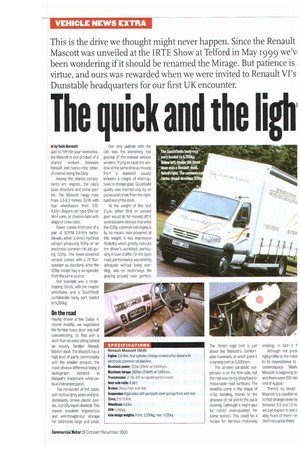The quick and the ligh
Page 15

If you've noticed an error in this article please click here to report it so we can fix it.
This is the drive we thought might never happen. Since the Renault Mascott was unveiled at the I RTE Show at Telford in May 1999 we'vl been wondering if it should be renamed the Mirage. But patience is virtue, and ours was rewarded when we were invited to Renault VI's Dunstable headquarters for our first UK encounter.
by Colin Barnett Just to refresh your memories, the Mascott is one product of a shared venture between Renault and lveco—the other, of course, being the Daily.
Among the shared components are engines, the cab's base structure and some panels. The Mascott range runs from 3.5-6.5 tonnes GVW with four wheelbases from 3.134.63m. Buyers can have 12m3 or 14ml vans, or chassis-cabs with single or crew cabs.
Power comes from one of a pair of SOFIM 2.8-litre turbodiesels, either a direct-injection version producing 105hp or an electronic common-rail job giving 123hp. The lower-powered version comes with a ZF fivespeeder as standard, while the 123hp model has a six-speeder from the same source.
Our example was a rangetopping 130.65, with the longest wheelbase and a Southfields curtainsider body, part loaded to 5,250kg.
On the road Having driven a few Dailys in recent months, we negotiated the familiar !yew door only half concentrating, to find with a start that we were sitting behind an equally familiar Renault Master dash. The Mascott has a high level of parts commonality with the smaller product, the most obvious difference being a tachograph installed in Renault's trademark white-onblue instrument panel.
The remainder of the cabin, with its blue/grey seats and predominantly brown plastic panels, is pretty much identical. This means excellent ergonomics and well-thought-out storage for oddments large and small. Our only quibble with the cab was the extremely low gearing of the manual window winders. Trying to raise the window at the same time as moving from a standstill usually includes a couple of interruptions to change gear. Good build quality was marred only by an occasional creak from the righthand end of the dash.
At the weight of this test truck, either first or second gear would do for moving off. It soon became obvious that while the 123hp common-rail engine is by no means over-powered at this weight, it has impressive flexibility which greatly reduces the driver's workload, particularly in town traffic. On the open road, performance was entirely adequate without being startling, and on motorways the gearing proved near perfect. The 70mph legal limit is just about the Mascott's comfortable maximum, at which point it is turning over at 3,500rpm.
The all-steel parabolic suspension is on the firm side, but the ride was rarely disturbed or reasonable road surfaces. The benefits come in the shape of crisp handling, thanks to the absence of roll and to the quick steering (although it might also be rather over-assisted for some tastes). This could be a recipe for nervous motorway cruising; in fact it f Although not presi high profile on the road; to its resemblance to commonplace MastE Mascott is beginning to and there were 200 sail end of August.
There's no doubt Mascott is a capable nE to that strange nevem between 3.5 and 7.5 to we can expect to see E ably more of them—e don't recognise them.












































































































